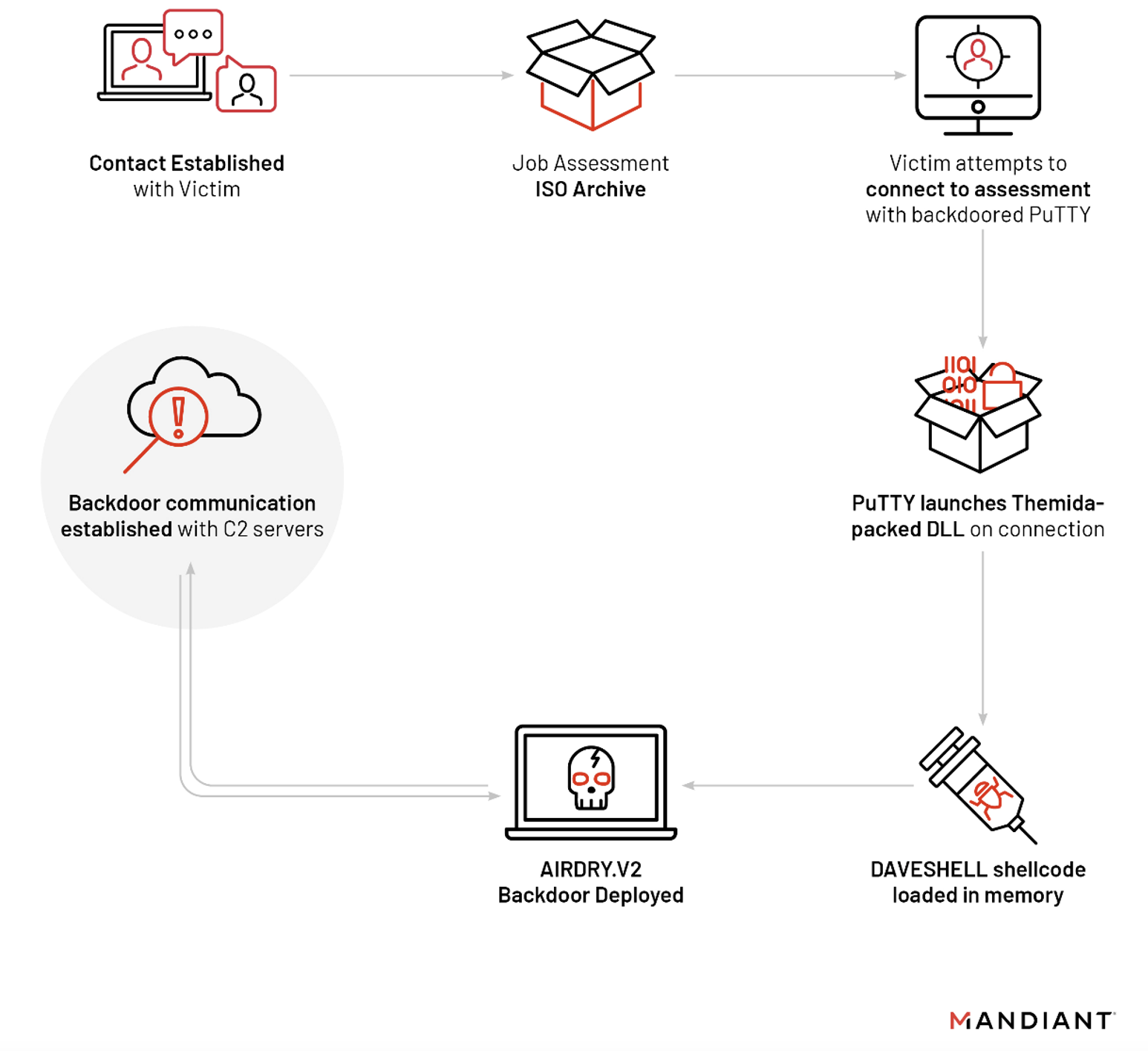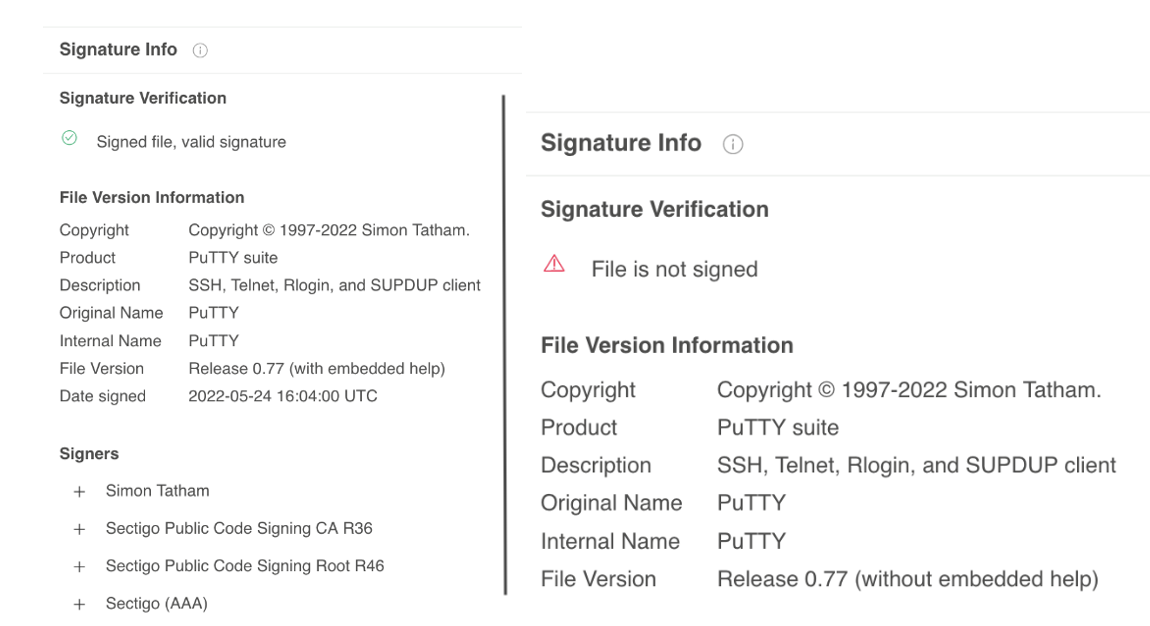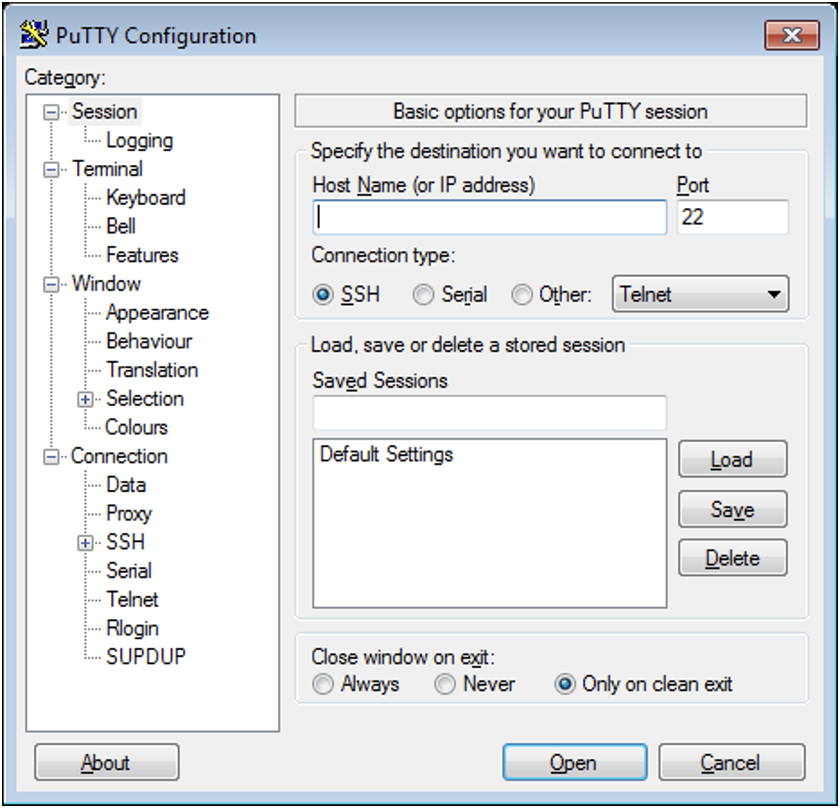It's Time to PuTTY! DPRK Job Opportunity Phishing via WhatsApp
Mandiant
Written by: James Maclachlan, Mathew Potaczek, Nino Isakovic, Matt Williams, Yash Gupta
In July 2022, during proactive threat hunting activities at a company in the media industry, Mandiant Managed Defense identified a novel spear phish methodology employed by the threat cluster tracked as UNC4034. Mandiant has identified several overlaps between this group and those we suspect have a North Korea nexus.
UNC4034 established communication with the victim over WhatsApp and lured them to download a malicious ISO package regarding a fake job offering that led to the deployment of the AIRDRY.V2 backdoor through a trojanized instance of the PuTTY utility.


The Managed Defense Threat Hunting Mindset
One of the cornerstones of the Mandiant Managed Defense service offering is its proactive threat hunting program that protects our customers from advanced threat actor’s tools, tactics and techniques that bypass traditional detection mechanisms. Managed Defense threat hunters leverage Mandiant’s deep adversary research and exposure to threat actor behaviors to continually enhance and expand our threat hunting capabilities.
This activity was identified by our Mandiant Intelligence: Staging Directories mission, which searches for anomalous files written to directories commonly used by threat actors.
The techniques used by UNC4034 in this compromise, along with the techniques used in countless intrusions investigated by Mandiant, are used to continuously develop and refine threat hunting hypotheses within Managed Defense. These provide high fidelity and actionable leads that are informed by evolving threat actor tradecraft.
Initial Lead
The initial lead was a file downloaded to the host named amazon_assessment.iso. ISO and IMG archives have become attractive to threat actors because, from Windows 10 onwards, double-clicking these files automatically mounts them as a virtual disk drive and makes their content easily accessible. This reduces the effort needed to view the embedded files compared to other formats such as RAR archives. Detecting malicious IMG and ISO archives served via phishing attachments is routine for Mandiant Managed Defense. The payloads contained within such archives range from commodity malware to advanced backdoors like the sample analyzed in this blog post.
Phishing Lure
Mandiant Managed Defense performed an investigation on the host to determine how the file amazon_assessment.iso was created. Based on the available data, Mandiant assesses that UNC4034 initiated communication with the victim by offering them a job opportunity at Amazon via email. Subsequently, UNC4034 communicated with them over WhatsApp and shared the file amazon_assessment.iso, which the user downloaded using the web version of WhatsApp.
The amazon_assessment.iso archive held two files: an executable and a text file. The text file named Readme.txt had connection details for use with the second file: PuTTY.exe.
Server: 137.184.15[.]189
User: test
Pass: [Redacted by Mandiant]
PuTTY is an open source SSH and Telnet client. Legitimate, compiled versions of the tool downloaded from the publisher’s website will have a valid digital signature. However, as shown in Figure 2, the PuTTY.exe binary in the malicious archive does not havea digital signature


Figure 2: Digital signatures of the officially distributed PuTTY utility (left) and the malicious version (right)
The size of the PuTTY binary downloaded by the victim is also substantially larger than the legitimate version. Upon closer inspection, it has a large, high entropy .data section in comparison to the officially distributed version (Figure 3). Sections like these are typically indicative of packed or encrypted data.


Figure 3: Comparing the .data section in the officially distributed PuTTY utility (left) and the malicious sample (right)
The suspicious nature of the PuTTY.exe embedded in the ISO file prompted Managed Defense to perform a deeper investigation on the host and the file itself.
The execution of the malicious PuTTY binary resulted in the deployment of a backdoor to the host. The deployed backdoor is an evolution of the malware family Mandiant tracks as AIRDRY. Mandiant Managed Defense successfully investigated the compromise and contained the host before follow-on activity resulting from the deployed backdoor could occur. While Mandiant detected and responded to the compromise on 2022-07-05, the same PuTTY executable was seen on VirusTotal as early as 2022-06-27.
In addition, Mandiant discovered a second ISO archive named amazon_test.iso uploaded to VirusTotal on 2022-06-17. Mandiant found the second archive by pivoting from the IP address contained in the Readme.txt file. This ISO file also had a Readme.txt with the same IP address and a similar trojanized PuTTY executable.
Both ISO files found by Mandiant appear to use the same lure theme by posing as a recruitment assessment for Amazon. They also contained similarly constructed malware that resulted in a final AIRDRY.V2 backdoor payload.
Malware Analysis
Trojanized PuTTY
The executable embedded in each ISO file is a fully functional PuTTY application (Figure 4) compiled using publicly available PuTTY version 0.77 source code.


Figure 4: PuTTY interface displayed when executing the malicious samples
Each sample contains malicious code that writes an embedded payload to disk and launches it. However, the malicious code was inserted at different locations in each of the trojanized PuTTY samples. In the PuTTY sample discovered by Mandiant, the code resides in the connect_to_host function, which is in the source file putty-0.77\ssh\ssh.c. To trigger the code, the user must attempt an SSH connection to the host IP address provided in the Readme.txt file (Figure 1).
In the PuTTY sample discovered on VirusTotal, the malicious code was inserted into the ssh2_userauth_process_queue function (source file: putty-0.77\ssh\userauth2-client.c). The code resides in the part of the function responsible for performing password authentication, as opposed to other methods such as public key or keyboard-interactive authentication. Once the user establishes a connection and enters their username and password, the malicious code is executed regardless of the authentication result. These execution guardrails are likely an attempt by UNC4034 to avoid unnecessarily dropping the next stage of their malware.
The part of the malicious code that drops and executes a payload is nearly identical between the two samples. The legitimate Windows executable C:\Windows\System32\colorcpl.exe is copied to the new directory C:\ProgramData\PackageColor and the embedded payload is written to C:\ProgramData\PackageColor\colorui.dll. The PuTTY binary observed in the compromise launches colorui.dll via DLL search order hijacking using the command shown in Figure 5.
C:\Windows\System32\cmd.exe /c start /b C:\ProgramData\PackageColor\colorcpl.exe
0CE1241A44557AA438F27BC6D4ACA246In the VirusTotal sample, cmd.exe is not used to launch colorcpl.exe. Instead, the Windows API function WinExec launches the process shown in Figure 6.
C:\ProgramData\PackageColor\colorcpl.exe C8E71F4613ABFCA10B6330C9In both instances, the command-line argument passed to colorcpl.exe is not related to the legitimate function of the Windows executable. Instead, each argument is utilized by the malicious DLL as described below.
Persistence is established for C:\ProgramData\PackageColor\colorcpl.exe via schtasks.exe. A scheduled task named PackageColor executes colorcpl.exe at 10:30AM local time every day.
Malicious DLL
Thecolorui.dll samples were packed using the commercial software protector Themida. The unpacked samples contain file paths that reveal their purpose. An example path is shown in Figure 7.
W:\Develop\aTool\ShellCodeLoader\App\libressl-2.6.5\crypto\cryptlib.cBoth samples contain an identical shellcode payload named DAVESHELL. The payload is decrypted using a custom XOR-based algorithm with a dynamically generated key. The key is the result of concatenating the following strings:
1. Parent process name (COLORCPL.EXE)
2. Malicious DLL filename (COLORUI.DLL)
3. Command-line argument passed to colorcpl.exe by the PuTTY executable
The necessary decryption key for the VirusTotal sample is shown in Figure 8.
COLORCPL.EXECOLORUI.DLLC8E71F4613ABFCA10B6330C96CA3D3B1The inclusion of this key also serves as an anti-analysis mechanism: without the correct key, nothing of significance happens when the DLL is executed.
The command-line argument passed to colorcpl.exe also dictates how the decrypted shellcode is executed. Based on this argument, colorui.dll may execute the shellcode from within colorcpl.exe or inject it into a new instance of a legitimate Windows process. In the case of process injection, the injection target is chosen randomly between credwiz.exe or iexpress.exe.
The injected shellcode payload is DAVESHELL, a publicly available dropper in the form of shellcode that executes an embedded payload in memory. The embedded payload is a VMProtect-packed evolution of the AIRDRY backdoor.
AIRDRY.V2
The AIRDRY backdoor, also known as BLINDINGCAN, has been thoroughly documented in reports published by CISA and JPCERT. These earlier versions of AIRDRY supported numerous backdoor commands including file transfer, file management, and command execution. In the most recent version, however, the traditional backdoor commands have been removed in favor of a plugin-based approach that supports multiple communication modes. The details that follow address the evolution to AIRDRY.V2 and highlight similarities with previous versions.
The backdoor’s configuration is AES-128 encrypted in CBC mode with the hard-coded key KAA5M8MNDKLJB8PI. An integrity check is performed on both the encrypted and decrypted configuration. The backdoor exits if the check fails.
The decrypted configuration contains the backdoor’s communication mode. Supported modes are listed in Table 1 along with their corresponding internal class names, where applicable. All three modes are centralized around a class named CSinSocket.
The structure of the embedded configuration is dependent on the communication mode. The observed sample is configured to use HTTP. The structure of its 0x24B0-byte configuration is outlined in Table 2. No SMB or file mode versions of AIRDRY.V2 have been identified and thus their configuration structure is unknown.
The configuration layout above is like the one outlined in Appendix A of the JPCERT report. The maximum beacon count stored at offset 0x1054 reflects the number of times the backdoor attempts to connect to a command and control (C2) server before waiting the amount of time stored at offset 0x105E. The current sample is configured to beacon up to five times before sleeping for 60 seconds.
By default, the backdoor is not configured to use a proxy server. It is also not configured to report the status of available disk space (offset 0x1056) or the presence of an active RDP session (offset 0x105E). However, these features could be enabled via a configuration update issued by a C2 server.
The configuration strings at offsets 0x18A0 and 0x1AA8 are not referenced in the code but have been seen in previous AIRDRY configurations. It’s possible these strings remain in the configuration for use by a downloaded plugin.
The configuration value at offset 0x1060 reflects the date and time after which the backdoor should begin communicating with its C2 servers. This value is empty in the current configuration, which results in communication beginning immediately. However, the value can be updated via a command from a C2 server, which could result in the backdoor being inactive for a period of time.
The backdoor’s C2 URL count is five; however, the configuration only has three distinct URLs (Figure 9).
hxxps://hurricanepub[.]com/include/include.php
hxxps://turnscor[.]com/wp-includes/contacts.php
hxxps://www.elite4print[.]com/support/support.aspThe backdoor issues an HTTP POST request to a randomly selected C2 URL. An example request is shown in Figure 10.
bbs=VkxXU1lPvBGI7BJ40K4=shD5nhF+2amakV9H&article=EAAAABIAAAAgAAAAAAAAAAAAAAAAAAAAgu
PGZC0NvqYJ/yy4qGzW98G5M6Ab5UDNTt3lna8k/O8=The bbs and article field names in the request body are hard-coded. The decoded Base64 data assigned to the bbs field aligns closely with the format outlined in the JPCERT report, including the same custom RC4 implementation. Where AIRDRY.V2’s request structure differs from its predecessor is the second field, which is used to send command-related data. Prior to being Base64 encoded, the article data is compressed using LZ4 and then encrypted with AES. The AES-256 key is derived using the SHA256 hash of a hard-coded 32-byte sequence.
AIRDRY.V2’s file mode uses the same HTTP request format but writes each request to a file. The file path is built based on elements found in the backdoor’s configuration. Because a file mode version of AIRDRY.V2 has not been identified, the purpose behind writing HTTP requests to a file has yet to be determined. In SMB mode, the backdoor communicates by sending an SMB2 WRITE request to a named pipe. The host name and pipe name are specified in the configuration.
Like previous AIRDRY backdoors, AIRDRY.V2 utilizes the value 0x2040 to request a command from a C2 server. Supported command IDs are listed in Table 3.
AIRDRY.V2 supports nine commands. Prior versions of AIRDRY supported nearly thirty commands. Of the nine commands, only two were not present in previous AIRDRY samples: 0x2052 and 0x2057. Command 0x2052 can be used to update the 32-byte sequence used to derive the AES-256 key described above. Command ID 0x2057 represents the shift from a backdoor that supports numerous commands to the new plugin-based approach in AIRDRY.V2.
Downloaded plugins are executed in memory and provided with a structure that includes a copy of the decrypted configuration, the system ID, and an object that facilitates communication with the configured C2 servers. Notably the backdoor itself has the necessary logic to function as a plugin.
Threat Actor Spotlight: UNC4034
Mandiant identified several overlaps between UNC4034 and threat clusters we suspect have a North Korean nexus. The AIRDRY.V2 C2 URLs belong to compromised website infrastructure previously leveraged by these groups and reported in several OSINT sources. Of note is the prior use of this compromised infrastructure to deliver the AIRDRY backdoor via CUTELOOP downloaders embedded in malicious documents.
Based on the identified overlaps and the social engineering tactics used, Mandiant suspects this activity represents an extension of enduring “Operation Dream Job” campaigns that leverage a different attack chain with ISO files and trojanized binaries rather than weaponized documents. This is likely one of several malware delivery techniques being employed by North Korean actors after a target has responded to a fabricated job lure. Recent public reporting also details the usage of other social media platforms to pose as legitimate companies and post fake job advertisements that target cryptocurrency developers.
The use of ISO files has become increasingly popular in the delivery of both commodity and targeted malware. Mandiant has observed well-known actors, such as APT29, adopting the use of ISO files to deliver their malware.
Detection Opportunities
The investigation into this compromise revealed new leads and indicators to pivot from in future hunting efforts. An important caveat to these hunting leads is that they are not indicators of compromise. Instead, they are interesting activity that may call for further investigation by an analyst.
These include ISO and IMG archive files downloaded from sources such as WhatsApp, email providers, and cloud storage services. On Windows 10 and later, the origin URL of a downloaded file is stored in the Zone.Identifier alternate data stream. Mandiant routinely observes archive files delivered as phishing attachments that originate from those sources.
The second hunting lead is the execution of colorcpl.exe from an unusual directory like C:\ProgramData\PackageColor. Most often, the executable runs from its standard location in C:\Windows\System32 or C:\Windows\SysWOW64.
The third hunting lead found for future hunting efforts is the execution of colorcpl.exe with command-line arguments. By default, colorcpl.exe executes with no command line arguments. In this scenario, colorcpl.exe was executed with a command-line argument that consisted of hexadecimal characters. The argument was ultimately evaluated by a malicious DLL that was loaded into the process.
Mandiant consistently finds new and novel threat actor activity such as the one described in this blog post. To ensure our customers are protected, Mandiant’s detection and threat hunting capabilities are continuously evolving and are fueled by our experiences on the frontlines.
Malware Family Definitions
DAVESHELL
DAVESHELL is shellcode that functions as an in-memory dropper. Its embedded payload is mapped into memory and executed.
AIRDRY
AIRDRY is a backdoor written in C++ that communicates via HTTP. Its capabilities include shell command execution, file transfer, secure file deletion, file management, process termination, and process enumeration.
AIRDRY.V2
AIRDRY.V2 is an evolution of the AIRDRY backdoor that supports three communication modes: HTTP, file-based, and SMB. AIRDRY.V2 does not support the extensive list of commands found in AIRDRY. Instead, its functionality is extended via downloaded plugins that are executed directly in memory. AIRDRY.V2 can also update its configuration.
CUTELOOP
CUTELOOP is a downloader written in C++ that retrieves payloads via HTTPS. Downloaded payloads are mapped into memory and executed. CUTELOOP expects a command-line argument that is used to decrypt the payload URL.
Technical Indicators
Host and Network-based Indicators
MITRE ATT&CK Mapping
